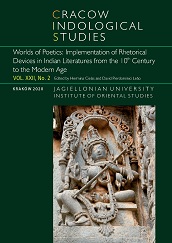Exit God: Border Crossings in Jīrṇoddhāra Procedure
Exit God: Border Crossings in Jīrṇoddhāra Procedure
Author(s): Libbie MillsSubject(s): Customs / Folklore, Studies of Literature, Theology and Religion, Sociology of Religion
Published by: KSIĘGARNIA AKADEMICKA Sp. z o.o.
Keywords: jīrṇoddhāra; saṅkocana; niṣkrāmaṇa; sūtracchidā; Tantrasamuccaya; Piṅgalāmata;
Summary/Abstract: Jīrṇoddhāra, the disposal and replacement of an old idol or temple, necessitates the temporary departure of the deity from that place. The ritual for this departure will be followed as it is reported in two texts: the Piṅgalāmata and the Tantrasamuccaya. The Piṅgalāmata is useful in understanding the process of jīrṇoddhāra: the text defines the process, explains the need for it, rationalises the ritual procedure, and gives a brief account of it. The description in the Tantrasamuccaya gives finer detail on how the procedure should be carried out. Unlike other records of the subject, that of the Tantrasamuccaya does not glide over the most important moments of transition for the deity, but stops to consider them in depth, giving attention to his displacement in terms of saṅkocana (contraction), niṣkrāmaṇa (expulsion), and sūtracchidā (the severing of the cord). While this pair of texts offers the material in contrasting forms, the two sets of teaching are found to be congruent one with the other, making them companion pieces that give us a good view into what it means to invite the deity to leave. We find that in order for the deity to cross concentric borders to leave his base, the human ritual officiant must make a crossing too, and, indeed, the borders themselves will be moved around.
Journal: Cracow Indological Studies
- Issue Year: 22/2020
- Issue No: 1
- Page Range: 187-220
- Page Count: 34
- Language: English

